PREPARING YOUR BOAT FOR SUMMER
Rhodey and Dizzy, from ‘Allthe Gear But No Idea’, take a look at a preseason boat maintenance schedule that might just make your time on the water safer and more enjoyable.
As the weather warms up and spring rolls around, anglers across the state begin to feel a bit more optimistic about the upcoming prospects of longer days, time off work and more favourable boating conditions to target the state’s warmer weather species.
With more time planned on the water in the upcoming months, now is a great time to do a once-a-year ‘spring clean’ of the boat, safety equipment and fishing gear to ensure it is all ready to go when the time is here. We often like to set aside a sunny day, when the wind is a bit much, to head out fishing and commit an afternoon to getting ourselves organised. This can also be a great time to make sure all of those once-a-year jobs are completed.
The best way to start this process is by taking ever y thing out of the boat, not only to stocktake what you do or don’t have, but also to provide the chance to clean behind the area where all your tubs and gear is stored. Taking ever y thing out of our dry bags and tubs and laying it all out on the lawn gives us a chance to take stock, clean ever y thing up and also a chance for ever y thing to dry thoroughly before returning it to its rightful home. This also gives us the opportunity to take out the pool matting that sits on the floor of the boat and pressure wash out any built-up debris or marking.
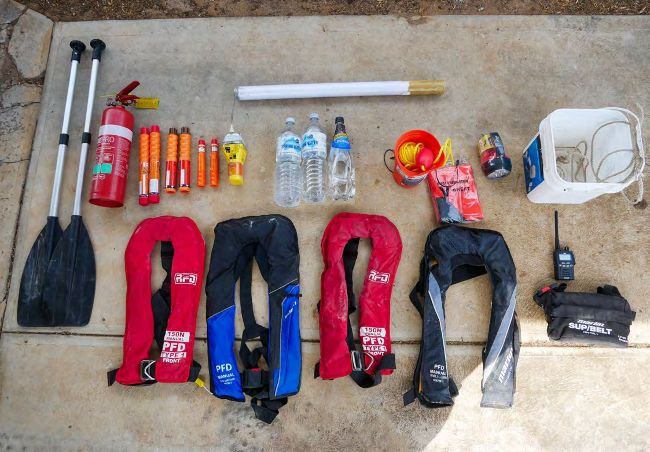
Another option can be to take the boat to the local carwash to use the high-pressure hose and soap brushes to give your boat a deep clean, both inside and out. For both this ‘spring clean’ and also your regular cleans it can be well worth using a salt removal product for any build- up of salt. This particularly applies to any moving parts, exposed metal, and equipment subject to seizing up from salt corrosion, like pliers. These sorts of products can also often be used to flush through your motor, using a mixer connected before the hose plugs into the earmuffs.
Unwinding the anchor rope for a rinse in a salt removal product and to ensure it is all in good condition can be another job worth doing. This can also be a good time to check the entire length of the rope for any damage and to make sure there are no twists or kinks and ensure it is all winding on evenly.
A large tub filled with soapy water makes it easy to clean off and freshen up life jackets, which are generally just rinsed off during the year. This is also the time to assess your life jackets for any damage and ensure that they are good to go again for the next 12 months. You are able to self assess that your inflatable lifejackets are still in working order by checking the canister for corrosion, weighing the canister to ensure it is within a specific weight range, and checking that the life jacket will hold air pressure overnight. You can then record this self service on the life jacket, giving you great peace of mind that your PFD is ready to go.
We then give the waders and winter jackets that live mostly on the boat during the colder months a bit of a soak, before hanging them in the sun to dry and air out. Gumboots and stubby holders can also do with a trip through the soapy water to freshen them up.
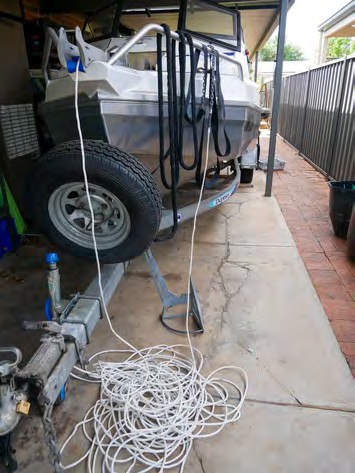
Look after your anchor rope and it will look after you
Fishing rags and towels that are often only hosed off and hung up to dry after a day out can also be soaked if they are in good enough condition to keep. If you’re really game, you may even bring these inside and run them through the washing machine. Often this is a good excuse to throw out shabby looking towels before raiding the linen cupboard for some replacements!
The next lot of gear to clean out is your pliers, bait knives, chopping boards, gaffs, landing nets and scaling bags that live in the gunwales of the boat. For us, this is often time to start the Christmas list and figure out what gear is looking a bit worse for wear and due for an upgrade. We give all of these tools a thorough clean before drying in the sun and a good soaking of any metal with some WD 40 or CRC to keep everything in good working order. A sharpen of any bait knives is generally in order, with priority normally given to keeping our filleting knives razor sharp throughout the year.
A trip to Bunnings and the supermarket is a must, to make sure you have plenty of those bits and pieces that are important to have on the boat. Zip ties for securing crab baits, snap lock bags for storing fillets before they make their way to the vacuum sealer, and electrical tape for any quick fixes are all worth restocking. Keeping a plastic storage tub with some spare fuses, a spare bung and spare key for the motor is also worth considering.
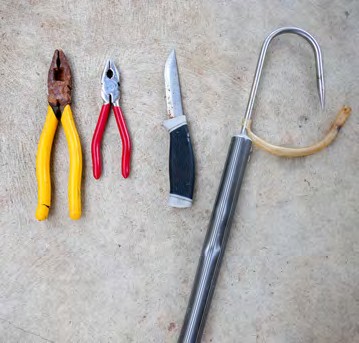
Some of the hardware you will need
In terms of maintaining the boat itself, this is often a great time to have the engine serviced and the whole boat looked over by a mechanic, especially for those who venture wider offshore chasing southern bluefin tuna and other pelagic species. There are a number of great boat mechanics who will visit your home to service your boat. It can also be advantageous to take your boat back to the relevant dealer for consistency, and to ensure the mechanic is an expert on that particular type of vessel.
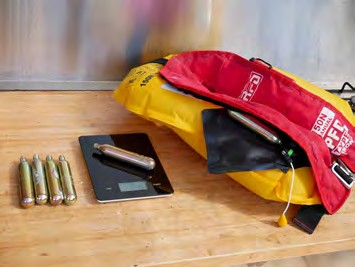
Fussy boaties often weigh PFD canisters
One other crucial thing that is often a bit neglected by boaties is trailer maintenance. Checking that all of the rollers are in good condition and spinning freely, assessing the wiring for any damage, pumping up the trailer tyres to the right pressure and generally giving the entire trailer a once over is definitely worthwhile doing. We recommend getting the brakes and bearings serviced by a professional, and this can often be done at the same time as the engine service for convenience. Similarly to the anchor rope, you should pull out all of the winch strap and sort out any twists or tangles, spray with a salt removal product and give it the once over to check for any damage.
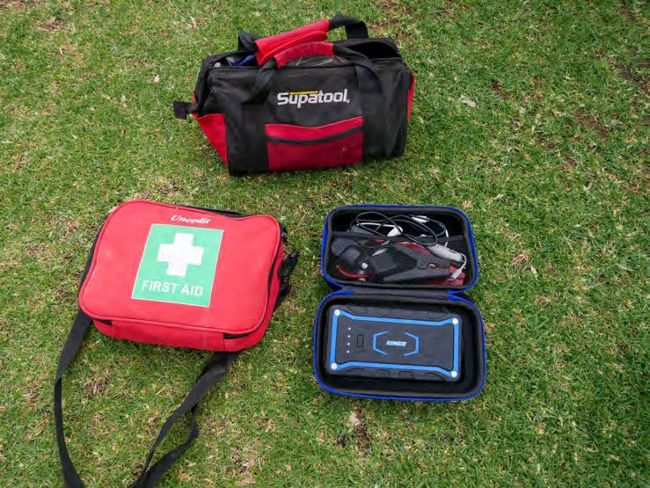
Some valuable items to consider
While we don’t really keep lots of tackle in our boat, instead preferring to pick and choose which specific boxes we need to take out on a particular day or weekend, it’s also a good chance to sort through and organise your tackle trays as well. Gear that you only use in a certain part of the year, such as tuna lures, is definitely worth checking as you near that busy season. Rusty hooks or swivels and any frayed line from your last day out in the previous season should be replaced in advance, so you don’t find yourself battling with split ring pliers and tying knots when out at sea chasing tuna for the first time of the season. It’s also worth topping up and organising your sinkers into some tubs suitable for different weights or different types of fishing.
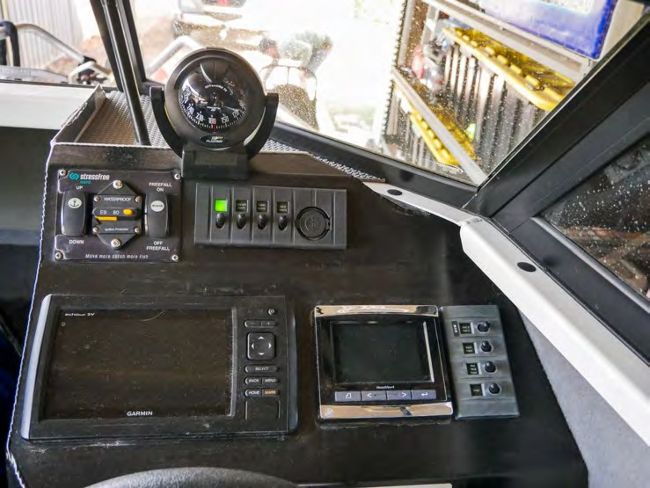
Test all your electronics to ensure they are working as they should
As we pack our safety gear back up, with most of ours being stored in a large red dry bag for easy access, we have the Marine Safety SA website open and check off all the requirements for the size of boat and type of waters we fish. This ensures nothing has been misplaced or the rules have changed in the past 12 months, and removes any doubt you may have when you do come across Marine Safety! Expiry dates on your EPIRB, flares and fire extinguisher need checking. We then put an appointment in our phone calendar to replace them at least a month before they go out of date. Common mistakes people make include not having enough fresh water, an appropriate bailing bucket tied to a piece of rope and having a torch that has run out of battery.
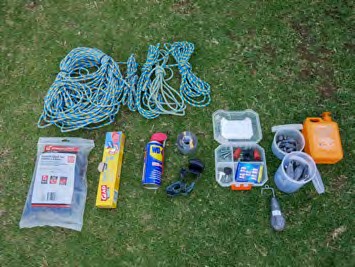
Before returning everything to your boat, now is the time to decide whether you really need to have certain bits and pieces on board. We have recently removed some of the matting from the front of our boat, as sand and seaweed were getting caught in it, and also have decided that we no longer need to carry large fenders. Removing any duplicates is also well worth doing. We can regularly end up with three or four half bottles of sunscreen, multiple measuring mats, heaps of spare jumpers, hundreds of lengths of different rope and all sorts of other double ups that can be removed. Anything not necessary is just wasting space, and as we all know, storage on a boat is quickly filled. Everything should be fully dried before being put back into the boat, and this is also the time to have a think about whether you have been happy with your previous storage layout.
Once everything has been checked off, thoroughly cleaned and re organised, it really does make your pack up and boat clean after each trip out a lot faster and easier. Particularly so if you tend to follow our motto of having ‘All The Gear But No Idea’!